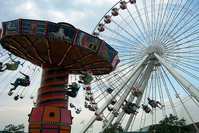Fun is good
The wind in your hair. The rush of motion. The breathtaking view of the landscape. These are some of the joys of riding in a machine invented right around the turn of the twentieth century. I’m talking about the Ferris wheel.
Riding in Ferris wheels is a lot of fun. Millions of people do it. They’ve appeared in countless American movies. And that’s why, no matter what some “Smart Growth” advocates try to do to restrict Ferris wheels, the DC government should continue structuring its public policy around ensuring free and unlimited Ferris wheel rides.
Fun is watching the brightly colored gondolas spin around and around. Stopping at the top while people get on and off at the bottom may be much derided, but the time alone with your thoughts at the top of the wheel is incredibly relaxing. Ferris wheels may be just a wheel and a motor to some, but to most they provide the childlike joy and feeling of freedom they want. Teacups, Scramblers, and bumper cars may provide brief glimpses of fun, but are never loved like Ferris wheels.
Streets like 15th Street, NW used to have much wider front yards for the houses, but during the twentieth century DC took away much of this “public parking” area to construct Ferris wheels. After decades of designing the city around Ferris wheels, there is one on almost every block, but that’s simply not enough. Residents of some denser neighborhoods complain about having to wait as much as a half hour to get on a Ferris wheel when they come home.
That’s why we need zoning rules that require all new apartment buildings to construct Ferris wheels on their property. That’s also why some Councilmembers have introduced legislation to spend public money on constructing new Ferris wheels, and some people have advocated tearing down buildings like the Reeves Center to put in Ferris wheels.
Some “Smart Growth” advocates suggest instead that we end the current policy of keeping all rides free and letting people ride as many times as they want in a row. They say this is unfair, because some people keep taking up Ferris wheel seats all evening, and propose “performance Ferris riding” to set a market price for rides. But that will hurt poor people. “Smart Growth” advocates may try to make Ferris wheels more inconvenient or more expensive, but people still want to enjoy the rush of riding high atop the city in Ferris wheels. Some residents feel that the Ferris wheels “tower over” their houses and the bright lights late into the night interfere with their sleep, but that’s just part of the fun.
Obviously, the above is farcical. Yet it’s the very argument Gary Imhoff made on Sunday with his ode to the private automobile. He derided the “Smart Growth” advocates for daring to suggest that cars ought not be king in all circumstances. After all, they’re so much fun:
Fun isn’t just sports cars and muscle cars going twenty or thirty miles over the speed limit. It’s also the toy cars — Volkswagen bugs in the 1960’s and smart cars today — that make everybody smile. … Fun is also the comfy, cushy sedans associated with staid uncles and aunts. … Fun is the pickups that let their owners feel they can do any job they need to do.
The point Imhoff and others miss is that we don’t subsidize most other forms of fun. Just because something is fun doesn’t mean our public policy should give that fun priority over other fun, or that we should devote substantial public land to that fun at great taxpayer expense, or require new buildings to spend millions of dollars to accommodate the fun, crowding out other uses. Imhoff’s argument appears to boil down to this: either something is good, or bad. If it’s good, then any policy that increases it is good, and any advocate for any policy that says otherwise must be trying to destroy the happiness that comes with it.
There’s nothing wrong with finding cars to be fun. Of course, other people find walking, bicycling, and taking Metro fun. Imhoff writes, “Subways and buses are the appliances, conveniences that can be appreciated but are never loved.” Many Greater Greater Washington readers, I suspect, beg to differ. Many commuters stuck in traffic, meanwhile, don’t find cars much fun at all. Why are the desires of those who enjoy walking or bicycling insignificant, while those of the car enthusiast paramount? Nobody’s advocating to outlaw auto shows or vintage car parades.
The irony of Imhoff’s argument becomes most clear at the end of his love letter, when he writes,
Drive the 14th Street Bridge over the Potomac River, and if your timing is right you can see a thrilling sight. On the bridge will be cars, bicycles, and pedestrians; on the next two bridges will be a train and a subway car; underneath will be boats on the Potomac; and above will be airplanes coming in for a landing at Reagan National Airport. It’s the history of transportation, of the twentieth century, in one spot.
That spot is indeed thrilling. But, as Imhoff noted, your timing has to be perfect to catch a fleeting glimpse of the walkers, bikers, boats, trains and planes on 14th as you speed across the bridge and keep your attention on the road. But there’s a much easier way to take in the glory of the bridges over the Potomac: walk or bike there. It’s too bad Imhoff doesn’t consider that much fun.

